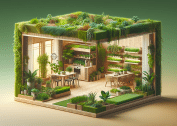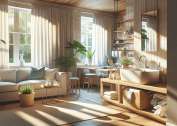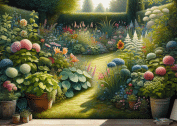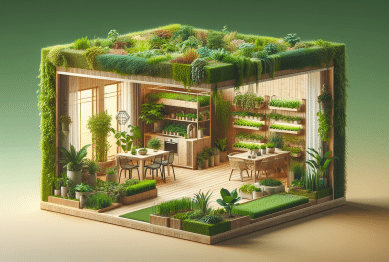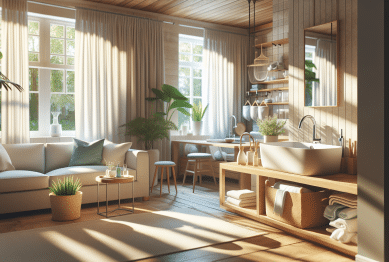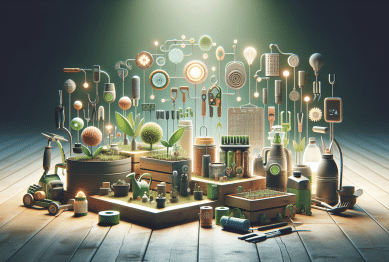As modern lifestyles continue to evolve, a growing number of people are discovering the profound benefits of bringing greenery indoors. Indoor plants are no longer just decorative elements; they have become essential components of wellness routines, home aesthetics, and sustainable living.
This year, indoor plants are at the center of a cultural shift towards more mindful, nature-connected living. In this guide, we explore why indoor plants have become a must-have trend and how they contribute meaningfully to everyday life.

The Rise of Indoor Plants in Modern Lifestyle
Interest in indoor plants has surged dramatically over the past few years. According to a report by Garden Center Magazine (2024), indoor plant sales in the U.S. rose by over 40% compared to pre-pandemic levels, and the trend shows no signs of slowing.
Factors fueling this movement include:
- Increased time spent at home
- A growing focus on mental health and stress relief
- Eco-conscious design trends emphasizing biophilic elements
- The rise of social media plant communities inspiring new plant enthusiasts
Indoor plants now serve both functional and emotional needs, making them an integral part of modern life.
Benefits of Indoor Plants That Go Beyond Aesthetics
1. Stress Reduction and Mood Improvement
Numerous studies demonstrate that being around plants can significantly reduce stress levels. A recent study by Psychology Today (2024) found that people working near plants experienced a 15% increase in self-reported well-being and a 10% improvement in task concentration.
Benefits include:
- Lower cortisol levels
- Improved mood and emotional balance
- Enhanced productivity
Simple interactions like watering, pruning, or even just observing plants promote mindfulness and relaxation.
2. Natural Air Purification
Plants naturally filter the air, removing toxins such as formaldehyde, benzene, and carbon monoxide. NASA’s Clean Air Study originally highlighted this benefit, and recent updates by Environmental Science & Technology Journal (2024) confirm that certain houseplants improve indoor air quality by up to 25% under typical living conditions.
Best Air-Purifying Plants:
- Snake Plant
- Peace Lily
- Spider Plant
- English Ivy
Cleaner air contributes to better respiratory health and improved sleep quality.
3. Boosting Interior Aesthetics and Creativity
Indoor plants introduce vibrant colors, organic shapes, and soothing textures that soften interior environments.
Design trends for 2025 favor lush, green spaces, with emphasis on natural light and organic materials.
Popular Plant Styling Trends:
- Hanging planters and vertical gardens
- Grouping small plants for visual impact
- Combining different textures like ferns, succulents, and large leafy plants
A well-curated indoor garden can dramatically transform the energy and visual appeal of a space.
How to Start Your Indoor Plant Journey
If you’re new to indoor plants, the process can feel overwhelming. Here’s a simple, practical approach:
Choose Beginner-Friendly Plants
Opt for resilient, low-maintenance varieties:
- Pothos: Tolerates low light and irregular watering.
- ZZ Plant: Almost indestructible and thrives in a range of environments.
- Aloe Vera: Doubles as a medicinal plant for skin care.
Match Plants to Your Light Levels
Different plants have varying light needs:
- Bright light: Fiddle Leaf Fig, Cacti
- Indirect light: Monstera, Philodendron
- Low light: Sansevieria, Cast Iron Plant
Observing your home’s lighting patterns helps ensure plant health and success.
Develop a Watering Routine
Overwatering is the most common mistake. A general rule: check the soil with your finger. If it feels dry two inches below the surface, it’s time to water.
Understand Plant Needs Seasonally
In winter, most plants go dormant and require less water and fertilizer. Adjust your care routine seasonally for the best results.
Indoor Plant Trends Emerging This Year
| Trend | Details |
|---|---|
| Statement Plants | Large species like Bird of Paradise or Fiddle Leaf Figs as room centerpieces |
| Plant Shelfies | Displaying curated plant collections on stylish shelving |
| Propagation Stations | Growing new plants from clippings in glass vases |
| Miniature Edible Gardens | Small setups of herbs like basil, mint, and thyme indoors |
Plant-related content on platforms like TikTok and Instagram is reinforcing these trends by offering DIY tutorials and plant care tips for beginners and experts alike.
Common Mistakes New Plant Owners Make
| Mistake | Solution |
|---|---|
| Overwatering | Stick to a schedule and check soil moisture |
| Poor Light Matching | Research the plant’s natural habitat needs |
| Ignoring Seasonal Changes | Reduce watering and feeding during dormant periods |
Learning through experience is part of the journey. Each plant adds unique rhythm and awareness to your daily routine.
Final Thoughts
It’s easy to see why everyone’s turning to indoor plants this year.
Indoor greenery provides more than beauty—it supports mental wellness, boosts physical health, and cultivates a deeper connection with the natural world.
By adding just a few plants to your living space, you engage in an accessible, rewarding lifestyle trend that aligns perfectly with today’s movement toward more mindful, balanced living.
Whether you’re a beginner or a seasoned plant lover, nurturing an indoor garden offers lasting rewards beyond what meets the eye.
References
- Garden Center Magazine. (2024). Indoor Plant Trends for 2025. Available at: www.gardencentermag.com.
- Psychology Today. (2024). Plants and Mental Health: New Research Highlights. Available at: www.psychologytoday.com.
- Environmental Science & Technology Journal. (2024). Updated Findings on Indoor Plant Air Purification. Available at: www.acs.org.
- NASA. (2024). Indoor Plants and Clean Air Studies: 2024 Reassessment. Available at: www.nasa.gov.

